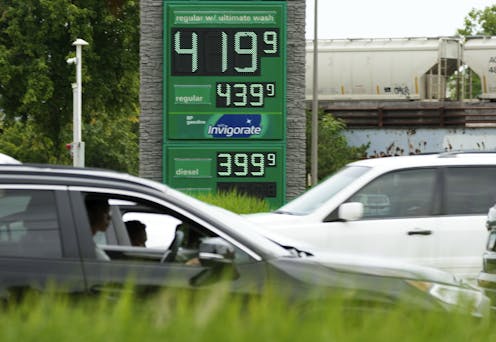Countries spend huge sums on fossil fuel subsidies – why they’re so hard to eliminate
- Written by Bruce Huber, Professor of Law, University of Notre Dame
 Fossil fuel subsidies keep gas prices low in many countries.AP Photo/Nam Y. Huh
Fossil fuel subsidies keep gas prices low in many countries.AP Photo/Nam Y. HuhFossil fuels are the leading driver of climate change, yet they are still heavily subsidized by governments around the world.
Although many countries have explicitly promised to reduce fossil fuel subsidies to combat climate change, this has proven difficult to accomplish. As a result, fossil fuels remain relatively inexpensive, and their use and greenhouse gas emissions continue to grow.
I work in environmental and energy law and have studied the fossil fuel sector for years. Here’s how fossil fuel subsidies work and why they’re so stubborn.
What is a subsidy?
A subsidy is a financial benefit given by a government to an entity or industry. Some subsidies are relatively obvious, such as publicly funded crop insurance or research grants to help pharmaceutical companies develop new drugs.
Others are less visible. A tariff on an imported product, for example, can subsidize domestic manufacturers of that product. More controversially, some would argue that when a government fails to make an industry pay for damage it causes, such as air or water pollution, that also amounts to a subsidy.
Subsidies, especially in this broader sense, are widespread throughout the global economy. Many industries receive benefits through public policies that are denied to other industries in the same jurisdiction, such as tax breaks, relaxed regulations or trade supports.
 German farmers drove tractors to Berlin in 2023 to protest a government plan to cut fuel subsidies.Michele Tantussi/Getty Images
German farmers drove tractors to Berlin in 2023 to protest a government plan to cut fuel subsidies.Michele Tantussi/Getty ImagesGovernments employ subsidies for political and practical reasons. Politically, subsidies are useful for striking bargains or shoring up political support. In democracies, they can mollify constituencies otherwise unwilling to agree to a policy change. The 2022 Inflation Reduction Act, for example, squeaked through Congress by subsidizing both renewable energy and oil and gas production.
Practically, subsidies can boost a promising young industry such as electric vehicles, attract business to a community or help a mature sector survive an economic downturn, as the auto industry bailout did in 2008. Of course, policies can outlive their original purpose; some of today’s petroleum subsidies can be traced to the Great Depression.
How are fossil fuels subsidized?
Fossil fuel subsidies take many forms around the world. For example:
In Saudi Arabia, fuel prices are set by the government rather than the market; price ceilings subsidize the price citizens pay for gasoline. The cost to state-owned oil producers there is offset by oil exports, which dwarf domestic consumption.
Indonesia also caps energy prices, then compensates state-owned energy companies for the losses they bear.
In the United States, oil companies can take a tax deduction for a large portion of their drilling costs.
Other subsidies are less direct, such as when governments underprice permits to mine or drill for fossil fuels or fail to collect all the taxes owed by fossil fuel producers.
Estimates of the total value of global fossil fuel subsidies vary considerably depending on whether analysts use a broad or narrow definition. The Organization for Economic Cooperation and Development, or OECD, calculated the annual total to be about US$1.5 trillion in 2022. Tche International Monetary Fund reported a number over four times higher, about $7 trillion.
Why do estimates of fossil fuel subsidies vary so dramatically?
Analysts disagree about whether subsidy tabulations should include environmental damage from the extraction and use of fossil fuels that is not incorporated into the fuel’s price. The IMF treats the costs of global warming, local air pollution and even traffic congestion and road damage as implicit subsidies because fossil fuel companies don’t pay to remedy these problems. The OECD omits these implicit benefits.
But whichever definition is applied, the combined effect of national policies on fossil fuel prices paid by consumers is dramatic.
Oil, for example, is traded on a global market, but the price per gallon of petrol varies enormously around the world, from about 10 cents in Iran, Libya and Venezuela – where it is heavily subsidized – to over $7 in Hong Kong, the Netherlands and much of Scandinavia, where fuel taxes counteract subsidies.
What is the world doing about fossil fuel subsidies?
Global leaders have acknowledged that subsidies for fossil fuels undermine efforts to address climate change because they make fossil fuels cheaper than they would be otherwise.
In 2009, the heads of the G20, which includes many of the world’s largest economies, issued a statement resolving to “rationalize and phase out over the medium term inefficient fossil fuel subsidies that encourage wasteful consumption.” Later that same year, the governments of the Asia-Pacific Economic Cooperation forum, or APEC, made an identical pledge.
In 2010, 10 other countries, including the Netherlands and New Zealand, formed the Friends of Fossil Fuel Subsidy Reform group to “build political consensus on the importance of fossil fuel subsidy reform.”
Yet these commitments have scarcely moved the needle. A major study of 157 countries between 2003 and 2015 found that governments “collectively made little or no progress” toward reducing subsidies. In fact, the OECD found that total global subsidies nearly doubled in both 2021 and 2022.
So why are fossil fuel subsidies hard to eliminate?
There are various reasons fossil fuel subsidies are hard to eliminate. Many subsidies directly affect the costs that fossil fuel producers face, so reducing subsidies tends to increase prices for consumers. Because fossil fuels touch nearly every economic sector, rising fuel costs elevate prices for countless goods and services.
Subsidy reform tends to be broadly felt and pervasively inflationary. And unless carefully designed, subsidy reductions can be regressive, forcing low-income residents to spend a larger percentage of their income on energy.
So, even in countries where there is widespread support for robust climate policies, reducing subsidies can be deeply unpopular and may even cause public unrest.
 Police and soldiers use tear gas to disperse a crowd protesting the rising cost of living following the removal of gasoline subsidies in Abuja, Nigeria, on Aug. 1, 2024.Emmanuel Osodi/Anadolu via Getty Images
Police and soldiers use tear gas to disperse a crowd protesting the rising cost of living following the removal of gasoline subsidies in Abuja, Nigeria, on Aug. 1, 2024.Emmanuel Osodi/Anadolu via Getty ImagesThe 2021-22 spike in fossil fuel subsidies is illustrative. After Russia’s invasion of Ukraine, energy prices surged throughout Europe. Governments were quick to provide aid for their citizens, resulting in their largest fossil fuel subsidies ever. Forced to choose between climate goals and affordable energy, Europe overwhelmingly chose the latter.
Of course, economists note that increasing the price of fossil fuels can lower demand, reducing emissions that are driving climate change and harming the environment and human health. Seen in that light, price spikes present an opportunity for reform. As the IMF noted, when prices recede after a surge, it “provide[s] an opportune time to lock in pricing of carbon and local air pollution emissions without necessarily raising energy prices above recently experienced levels.”
Bruce Huber does not work for, consult, own shares in or receive funding from any company or organization that would benefit from this article, and has disclosed no relevant affiliations beyond their academic appointment.
Authors: Bruce Huber, Professor of Law, University of Notre Dame

